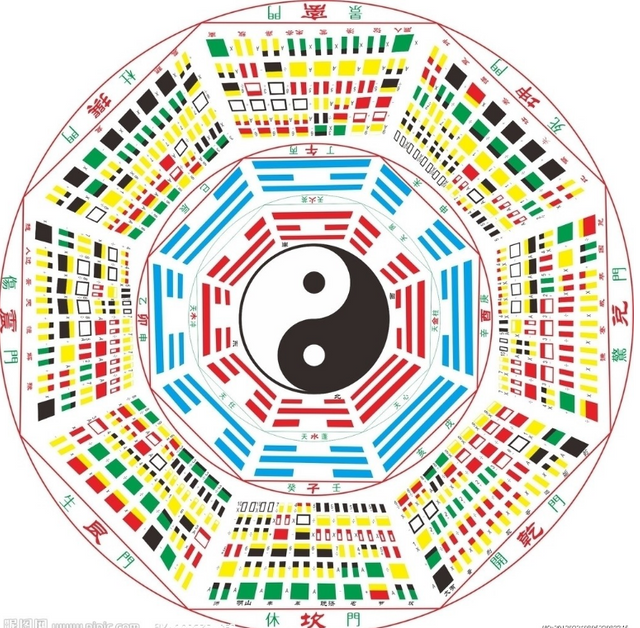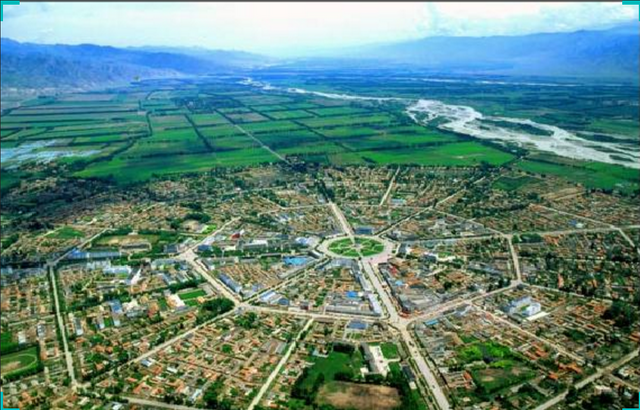A city build in Eight Diagrams Zhou Yi, my next travel destinations - Homework chapter 为新疆游做功课乌鲁木齐特克斯
The Bagua are eight trigrams used in Daoist cosmology to represent the fundamental principles of reality, seen as a range of eight interrelated concepts.There are many applications related to Bagua. Each consists of three lines, each line either "broken" or "unbroken," respectively representing yin or yang. Due to their tripartite structure, they are often referred to as "trigrams" in English.
The cause of the matter is this, the Chinese New Year students to talk about the fiery group, talk to you for many years not seen, and want to get together, but the choice of place is not easy to argue. Finally, received from the Urumqi University students of the invitation, a few old classmates to prepare in the first half to Urumqi to visit the students, at the same time under the leadership of students to play about the beautiful Xinjiang. My classmate grew up in Xinjiang, but it is completely Han people, according to him, he in addition to Urumqi, Xinjiang has only been a few places, so let us do their homework, see where we want to play with us Where to go.
Speaking of Xinjiang, my mind turned out to be a large pan chicken, lamb skewers and roast Nang, ah, I am indeed a cargo to eat. The students spoke enthusiastically, recommended a lot of places, I know, Xinjiang has a lot of treasures, such as southern Xinjiang Wada Meiyu. But said the field and remote, almost no Han, law and order are also general, so this option to delete.
There is also a student recommended a place called Tex County, is located in Yili. What is the place famous for? Some people may know, because the city is built in accordance with a map of the Eight Diagrams, is said to have no traffic lights, but not traffic jams. I also read some of the traditional literature, the Book of Changes in my mind it has been relatively mysterious, trying to read did not read.
The city is actually built entirely in accordance with the plan, and odd odd in the center of the city square to extend the culture of the eight main street, respectively, on behalf of their respective direction of the "dry, Kun, earthquake, Kan, Gen, Sunda, Against "each street building also has its own characteristics, including floor tiles are not the same. This is really interesting. I can refer to the pictures from the Internet search.
But as for why not traffic jams, I really did not want to understand, I guess there are boasting of the ingredients, may be less local car.
事情的起因是这样的,这次过年大学同学群里聊的火热,聊到大家很多年没见了,想聚一聚,但是选择的地方争论不易。最后,收到来自乌鲁木齐的大学同学的的邀请,几个老同学准备一起在上半年到乌鲁木齐拜访该同学,同时在同学的带领下游玩一下美丽的新疆。我这个同学自小长在新疆,但确是彻底的汉族人,据他说,他除了乌鲁木齐,也只去过新疆很少的地方,所以让我们自己做功课,看想去哪里玩就带我们去哪里。
一说到新疆,我脑子里想到的竟然是大盘鸡,羊肉串 和烤馕,啊,我不愧是个吃货。而同学们踊跃发言,推荐了很多地方,我才知道,新疆蕴藏了很多的宝藏,比如说南疆的和田美玉。不过据说和田地处偏远,几乎没有汉人,治安也一般,所以这个选项删除。
还有一个同学推荐一个地方叫特克斯县,地处伊犁。这个地方因为什么出名呢?可能有人知道,因为城市建设是按照一个八卦图建造的,据说没有红绿灯,但却不堵车。自小本人也是读过一些传统文学的,周易在我心目中却是一直比较神秘,试图读过也没读懂。
这个城市实际上是完全按照规划建造的,而奇就奇在以市中心文化广场为轴心延伸出的八条主街分别代表各自方向的“乾、坤、震、坎、艮、巽、离、兑”, 每条街建设的也各有特色,包括地面砖等都不一样。 这个真的很有意思。 可以参考一下我从网上搜到的图片。
但至于为什么不堵车,我确实没有想明白,我猜测有吹嘘的成分,可能这种地方车确实少吧。


在youtube看过一个八卦村的视频。不知是否同一地方。
这个是八卦城哦,不是村,呵呵
那该不一样吧。我看肯定我看到是八卦村的节目。